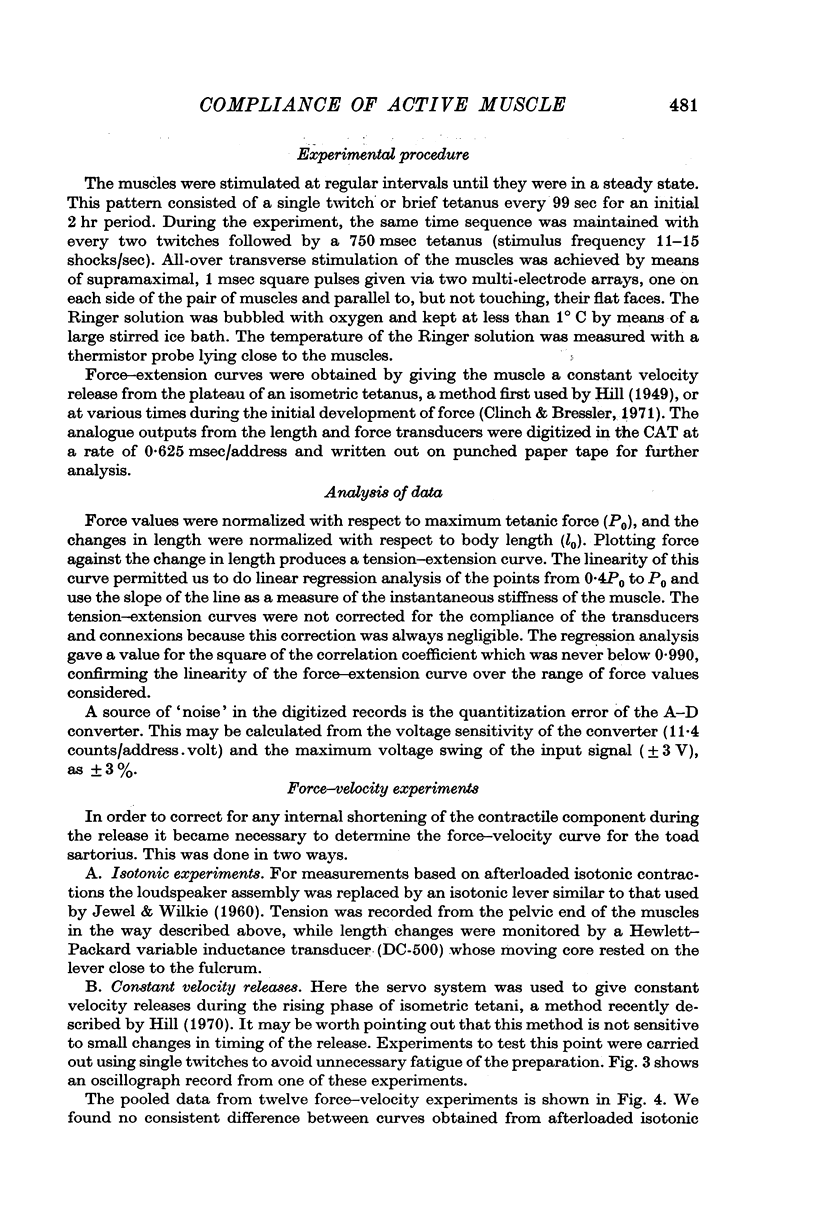Abstract
1. The method of controlled releases was used to obtain tension—extension curves in toad (Bufo bufo) sartorii under a variety of conditions at 0° C.
2. The curves obtained were approximately linear over a considerable range of force (0·4P0 to P0) if the releases were given from the plateau of tetanic tension. The slope of this linear region was little affected by changes of release velocity in the range 10-120 mm/sec.
3. Such changes as did occur with alterations in release velocity could be quantitatively accounted for in terms of the internal shortening predicted by A. V. Hill's two-component model.
4. As the muscles were stretched above l0, we found that the maximum stiffness of the tetanized muscles fell in much the same way as the maximum developed force, P0.
5. In another series of experiments we found a rapid change in the overall shape of the tension—extension curve during the early phase of force development in an isometric tetanus. The stiffness of the muscle increased with increasing developed force during this period.
6. The force—velocity curve in these muscles was measured by two methods, both giving a similar result. Surprisingly, toad muscle appears to have about the same intrinsic speed as frog muscle at 0° C. The a.b product from our experiments is considerably greater than the reported values for the maintenance heat rate at 0° C in these muscles.
7. The probable site of the variable compliance in active muscle is discussed. It seems most likely that this is within the A-band, perhaps in the cross-bridges themselves.
Full text
PDF
















Images in this article
Selected References
These references are in PubMed. This may not be the complete list of references from this article.
- ADRIAN R. H. The effect of internal and external potassium concentration on the membrane potential of frog muscle. J Physiol. 1956 Sep 27;133(3):631–658. doi: 10.1113/jphysiol.1956.sp005615. [DOI] [PMC free article] [PubMed] [Google Scholar]
- Civan M. M., Podolsky R. J. Contraction kinetics of striated muscle fibres following quick changes in load. J Physiol. 1966 Jun;184(3):511–534. doi: 10.1113/jphysiol.1966.sp007929. [DOI] [PMC free article] [PubMed] [Google Scholar]
- Clinch N. F., Tennant V. A. A loudspeaker servo system for use in studying muscle mechanics. J Appl Physiol. 1972 May;32(5):703–705. doi: 10.1152/jappl.1972.32.5.703. [DOI] [PubMed] [Google Scholar]
- Gordon A. M., Huxley A. F., Julian F. J. The variation in isometric tension with sarcomere length in vertebrate muscle fibres. J Physiol. 1966 May;184(1):170–192. doi: 10.1113/jphysiol.1966.sp007909. [DOI] [PMC free article] [PubMed] [Google Scholar]
- HILL A. V., WOLEDGE R. C. An examination of absolute values in myothermic measurements. J Physiol. 1962 Jul;162:311–333. doi: 10.1113/jphysiol.1962.sp006935. [DOI] [PMC free article] [PubMed] [Google Scholar]
- Huxley A. F., Simmons R. M. A quick phase in the series-elastic component of striated muscle, demonstrated in isolated fibres from the frog. J Physiol. 1970 Jun;208(2):52P–53P. [PubMed] [Google Scholar]
- Huxley A. F., Simmons R. M. Proposed mechanism of force generation in striated muscle. Nature. 1971 Oct 22;233(5321):533–538. doi: 10.1038/233533a0. [DOI] [PubMed] [Google Scholar]
- Huxley H. E., Brown W. The low-angle x-ray diagram of vertebrate striated muscle and its behaviour during contraction and rigor. J Mol Biol. 1967 Dec 14;30(2):383–434. doi: 10.1016/s0022-2836(67)80046-9. [DOI] [PubMed] [Google Scholar]
- JEWELL B. R., WILKIE D. R. An analysis of the mechanical components in frog's striated muscle. J Physiol. 1958 Oct 31;143(3):515–540. doi: 10.1113/jphysiol.1958.sp006075. [DOI] [PMC free article] [PubMed] [Google Scholar]
- JEWELL B. R., WILKIE D. R. The mechanical properties of relaxing muscle. J Physiol. 1960 Jun;152:30–47. doi: 10.1113/jphysiol.1960.sp006467. [DOI] [PMC free article] [PubMed] [Google Scholar]
- Katz B. The relation between force and speed in muscular contraction. J Physiol. 1939 Jun 14;96(1):45–64. doi: 10.1113/jphysiol.1939.sp003756. [DOI] [PMC free article] [PubMed] [Google Scholar]
- Parmley W. W., Sonnenblick E. H. Series elasticity in heart muscle. Its relation to contractile element velocity and proposed muscle models. Circ Res. 1967 Jan;20(1):112–123. doi: 10.1161/01.res.20.1.112. [DOI] [PubMed] [Google Scholar]
- RITCHIE J. M., WILKIE D. R. The dynamics of muscular contraction. J Physiol. 1958 Aug 29;143(1):104–113. doi: 10.1113/jphysiol.1958.sp006047. [DOI] [PMC free article] [PubMed] [Google Scholar]
- SONNENBLICK E. H. SERIES ELASTIC AND CONTRACTILE ELEMENTS IN HEART MUSCLE: CHANGES IN MUSCLE LENGTH. Am J Physiol. 1964 Dec;207:1330–1338. doi: 10.1152/ajplegacy.1964.207.6.1330. [DOI] [PubMed] [Google Scholar]
- Schädler M., Steiger G. J., Rüegg J. C. Mechanical activation and isometric oscillation in insect fibrillar muscle. Pflugers Arch. 1971;330(3):217–229. doi: 10.1007/BF00588613. [DOI] [PubMed] [Google Scholar]
- WILKIE D. R. Measurement of the series elastic component at various times during a single muscle twitch. J Physiol. 1956 Dec 28;134(3):527–530. doi: 10.1113/jphysiol.1956.sp005662. [DOI] [PMC free article] [PubMed] [Google Scholar]
- WOLEDGE R. C. The thermoelastic effect of change of tension in active muscle. J Physiol. 1961 Jan;155:187–208. doi: 10.1113/jphysiol.1961.sp006622. [DOI] [PMC free article] [PubMed] [Google Scholar]




